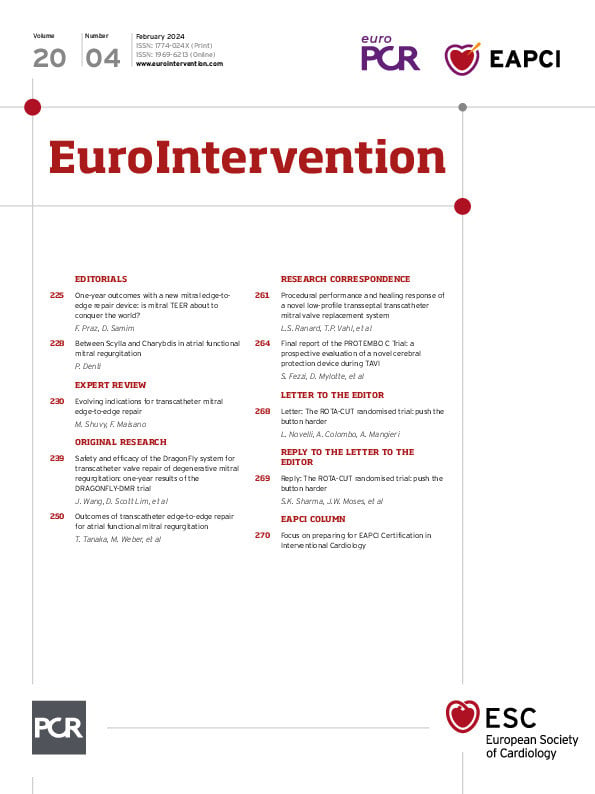We thank Novelli and colleagues for pointing out important aspects regarding the primary results of the ROTA-CUT trial1. We fully respect the authors and are aware of their great work and experience treating patients with severely calcified lesions. With respect to the points raised in their letter, we have the following answers:
1) With respect to the inflation pressure for the cutting balloon strategy, the ROTA-CUT investigators are very well aware of the data supporting the benefits of higher inflation pressures2. As mentioned in the discussion section of our manuscript3, the ROTA-CUT trial was conducted under U.S. Food and Drug Administration (FDA) investigational device exemption (IDE# G210030). It is important to note that compliance with the manufacturer’s instructions for use (IFU) was mandated and an inflation pressure of 12 atm was not to be exceeded. Therefore, we could not change that parameter without failing to meet compliance requirements according to the device label in the USA. To what extent the latter may have impacted the outcomes of ROTA-CUT and contributed to the discrepant results compared with the results of PREPARE-CALC-COMBO can only be speculated4.
2) Novelli et al also pointed out the mean stent length of approximately 38 mm in ROTA-CUT as a possible reason for the minimum stent area (MSA) being small in tapering vessels. First, it should be noted that drug-coated balloons are not yet approved in the USA and, therefore, longer stents may be needed to cover diseased areas. Considering the physiological tapering of the vessel, we agree that the MSA at the site of maximum calcification may be a valuable endpoint measure. In fact, such analyses were performed and did not show any important benefit for the strategy of rotational atherectomy (RA) followed by cutting balloon (CB) angioplasty when analysed post hoc. These data were not included in the manuscript, as they were not considered in the study protocol. Notably, MSA at the maximum calcification site by intravascular ultrasound (IVUS) did not differ between RA followed by CB angioplasty versus RA followed by non-compliant balloon (NCB) angioplasty (7.4±1.9 mm2 vs 7.8±2.1 mm2; p=0.424). It is important to note that ROTA-CUT is the first randomised controlled trial with detailed and robust intravascular imaging evaluation between a strategy of CB versus NCB angioplasty in which exceptional safety of the CB angioplasty strategy was demonstrated. Our results have highlighted the need for a prospective randomised trial to evaluate the efficacy of this strategy in treating severely calcified lesions.
Conflict of interest statement
R. Mehran reports institutional research payments from Abbott, Abiomed, Affluent Medical, Alleviant Medical, Amgen, AM-Pharma, Applied Therapeutics, Arena, AstraZeneca, AtriCure Inc., Biosensors, Biotronik, Boston Scientific, Bristol-Myers Squibb, Cardiawave, CeloNova (now Alta Biomaterials), Chiesi, Concept Medical, CSL Behring, Cytosorbents, Daiichi Sankyo, Duke, Element Science, Faraday, Humacyte, Idorsia, I-Laser, Janssen, Magenta, MedAlliance, Medscape, Mediasphere, Medtelligence, Medtronic, MJH Healthcare, Novartis, OrbusNeich, Penumbra, PhaseBio, Philips, Pi-Cardia, PLx Pharma, Protembis, RenalPro, RM Global, Shockwave Medical, Transverse Medical Inc., Vivasure, and Zoll; personal fees from Affluent Medical, Cardiovascular Research Foundation (CRF), Daiichi Sankyo Brasil, E.R. Squibb & Sons, Esperion Science, Innovative Biopharma, Europa Group, Boston Scientific, Gaffney Events, Educational Trust, Ionis Pharmaceuticals, J-CalC, Novartis, Novo Nordisk, Vectura, VoxMedia, IQVIA, McVeigh Global, Overcome, Primer Healthcare of New Jersey, Radcliffe, SL Solutions, TARSUS Medical Education, and WebMD; holds equity <1% in Applied Therapeutics, Elixir Medical, Stel, and ControlRad (spouse); no fees from AMA (Scientific Advisory Board) and SCAI (Women in Innovations Committee Member); Faculty CRF; and honoraria from JAMA Cardiology (Associate Editor) and ACC (BOT Member, SC Member CTR Program). The other authors have no conflicts of interest to declare.

